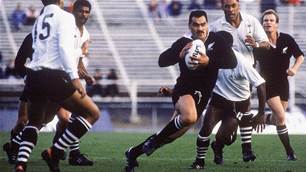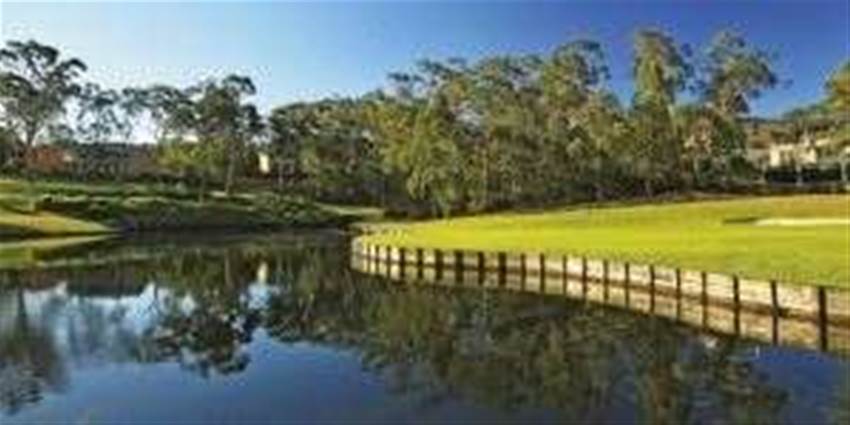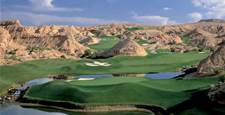The former home of tour events as big as the Australian PGA Championship is flourishing under new owners as it prepares to welcome a sister layout.
The former home of tour events as big as the Australian PGA Championship is flourishing under new owners as it prepares to welcome a sister layout next year.
Looking at the golf course today, it’s difficult to imagine I once walked off the 18th hole at Riverside Oaks adamant I wouldn’t be back.
It was a hot summer’s day in January 2004 and I had a good round going in the club’s ‘challenge’ day. You know the ones: the tee markers go right back and the holes are cut in tough spots on the greens and competing golfers win a prize simply for bettering their handicap. With two holes to play, I was a stroke or two under my handicap and looking good to better net par for the round. The 17th hole at Riverside Oaks doglegs sharply right, so sharply that your tee shot has to be curving quickly and purposefully just to stay in the fairway of the 396-metre par-4. Such an exaggerated shape means you give yourself a helping hand by teeing up on the far left side of the tee. The problem was, an overhanging branch made it impossible to do that on this day as you’d collect the tree with your club during the backswing. I had no choice but to shuffle right and try to slice the ball even further, however I duly blocked my drive into trouble, made an ugly double-bogey and took another six at the last to ruin a good score.
What happened on the 17th tee that day was a crime no greater than careless greenkeeping – and was something the entire field had to cope with. But on a hot day I let it get to me and vowed not to return.
Fast-forward nearly nine years and I confess that not only have I been back to Riverside Oaks since that day, but I have returned on at least half a dozen occasions. I made peace with the 17th hole after joining a group of keen golfers who use the course as a regular ‘home’ for their biannual golf weekends away. So it’s after multiple rounds and with much confidence that I state the Riverside Oaks of the mid-2000s was a shadow of the golf course it is now.
The rejuvenation escalated from 2009 when present owners the Nanshan Group assumed control of the club, purchasing it from former owner Pat Cunningham. Among its various interests, the Chinese conglomerate is the largest golf-course operator in China and little time passed before it reinvigorated its newest acquisition in Sydney’s north-west. Almost immediately the level of course conditioning improved and the resort made a smart move by redesigning the par-5 9th hole to create space for a full-length covered practice range, the absence of which had been a shortcoming to that point. Away from the course, refurbishments took place within the clubhouse and accommodation and, most significantly, Nanshan revived Cunningham’s long-held plans to build a second course and become Sydney’s only 36-hole club.
The second layout – known unofficially as the River course – will complement the original perfectly. With a site located much closer to the Hawkesbury River than the first course, the second layout sits on arguably superior land to the original and owns several natural differences to its counterpart. Yes, the river will be both in view and in play but the site is also blessed with an existing covering of couch grass while the bunker look and construction is another point of difference. Designed by Bob Harrison, the new course possesses the established gums and bush setting of the original yet will be more open and require a range of strategies in order to score well. The first nine holes should be open for play by next March with the second nine later in 2013.
Over on the original course, the alterations to the 9th hole arguably didn’t strengthen what was a solid par-5 to begin with, but they didn’t weaken it either. The blind drive still flies over a hill and through a chute of towering gum trees, however the fairway formerly maintained a relatively straight journey to a green set into a hillside near the clubhouse with several bunkers as protection. Now the fairway bends slightly to the right and runs downhill towards a newly created pond right of a new green. The putting surface might be easier to reach in two shots but gravity and the landform also feed bouncing balls straight towards the waiting water. The new practice area this design change helped create is located where the second part of the fairway used to be and is economical on space as it climbs a hill.
The 9th is a challenging par-5 but by far the most intriguing three-shotter comes three holes later. The 12th hole looks like an S-bend piece of piping, with the fairway snaking between two large lakes that need to be negotiated regardless of how many strokes you aspire to reach the green in. The putting surface was famously found in one crushing blow a few years ago when former Australian long-drive champion Mark Bylsma launched a towering bomb over the trees next to the first hazard, across the water and onto the green for an easy two-putt eagle. Mortals tend to fire a drive as close to the water as possible without going in it then a high fade onto or near the green. No.12 is a curious hole but it’s likely to tempt most who arrive on the tee.
Earlier, the par-5 opening hole finishes with one of the largest putting surfaces you’re likely to see. The green is so broad that a putter might not be enough club to traverse the entire width, as it plays like two greens in one with a ridge splitting the left half from the right. The rest of the front nine features medium-to-long par-4s at the 2nd, 3rd, 6th and 7th holes before moving to the scoring zone where there are three par-5s in four holes from the 9th. Sandwiched in between is the pretty downhill par-3 11th before four more tough par-4s to complete the examination.
Any par earned at the 15th is a good one indeed. A dogleg right with water lining the entire left side, the tee shot needs to bend left-to-right before a white-knuckle approach with water short and left of the green of the 400-metre par-4 and sand punishing those who flare one timidly to the right. The 16th requires a decision from the tee about how best to attack the hole while the two closers are long, strong par-4s with water in play – especially right of the 18th fairway but also sneakily left of the raised green of the home hole.
The 17th has changed markedly from when the course held the Australian PGA Championships of 1988, ’89 and ’90. Formerly a par-5, the first incarnation of the hole required a water crossing to find a green perched high above the water and with rocks also fronting the surface. Some years ago the decision was made to reduce it to a par-4 and relocate the green short of the water. At the same time the 12th moved from being a driveable par-4 to its current guise. The modern edition of the 17th might lack the drama of the par-5 version but it does bolster the imposing finishing stretch.
Oh, and my score the last time I played the 17th? Birdie. That tree hanging over the rear of the 17th tee? Like Riverside Oaks’ past problems, it’s long gone.
THE COURSE
LOCATION: O’Briens Rd, Cattai. From the Sydney CBD, head for the M2, exiting the M2 or M7 onto Old Windsor Rd. Turn right onto Pitt Town Rd and drive towards Wisemans Ferry for about 15 minutes. Riverside Oaks is on the left. The course is a 60- to 80-minute drive from the city centre.
CONTACT: (02) 4560 3220.
WEBSITE: www.riversideoaks.com.au
DESIGNERS: Ted Stirling & Bruce Hodson (1986); Peter Thomson & Mike Wolveridge (1990); Jack Newton, Graeme Grant & John Spencer (1994)
PLAYING SURFACES: Couch (fairways, tees); bent (greens).
PGA PROS: David Scott and Chris Fox.
GREEN FEES: $65-$75 on weekdays and $80-$90 on weekends and public holidays.
THE CLUB
MEMBERSHIPS: You can join Riverside Oaks for as little as $130, but are required to play a minimum of three competition rounds there per year (a $100 per-round penalty applies for not playing three). Members can buy an annual pass for $2,100, which covers play for 12 months.
ACCOMMODATION: The accommodation at Riverside Oaks comes in two forms: the relaxed lodge with a common living and outdoor area that’s perfect for groups, or the three or four-bedroom villas overlooking the picturesque par-3 11th hole. These villas feature large open-planned living, dining and kitchen areas and a wide balcony. Another 36 rooms are under construction and are expected to open by the end of 2013.
PACKAGES: Depending on the number of guests, stay and play packages in the villas range from $158.75 per person midweek in low season to $249.50 per person on weekends in high season. Rates for the lodge vary between $145 and $177.50 per person. All packages include nine holes after 2pm on the day of arrival, a self-cook barbecue dinner, continental breakfast and 18 holes with cart. Alternatively, the bed and breakfast rates range from $250 per room midweek in low season to $765 on weekends in high season (villa), or from $72.50 to $95 (lodge). Low season is January, February and May to August; high season is March, April and September to December.
Related Articles

International Spotlight: Omanu Golf Club

Celebrity Kiwi couple tee off in paradise












